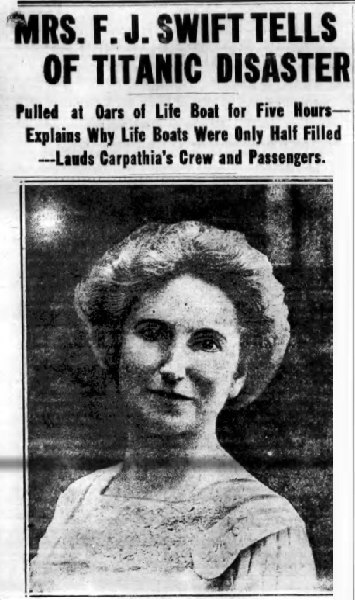Wendell: Leader localizes Titanic tragedy of 110 years ago

The cover of the Leader-Observer shortly after the April 15, 1912 disaster of the Titanic that left over 1,500 people dead. The Leader interviewed a resident of nearby Brooklyn who was well-known in this neighborhood and was a lucky survivor of that terrible disaster.
By Ed Wendell
The sinking of the RMS Titanic, the famed passenger ship which sank 110 years ago after striking an iceberg, was front page news around the world. The Leader-Observer was no exception, even finding a local angle on the fate of Margaret Welles Swift of nearby 171 Arlington Avenue in Brooklyn.
Mrs. Swift was well-known to locals in Woodhaven who belonged to the popular Fortnightly Library Club in Brooklyn, of which she was President. In the first issue after the disaster which left over 1,500 passengers dead, friends and relatives of Mrs. Swift were anxiously awaiting word of her fate.
Soon after it was confirmed that Mrs. Swift had survived she gave an exclusive account to the Leader. She began by describing the magnificence of the ship and told how the massive suction caused by its leaving port in Southampton drew the two ships on either side of her from their moorings.
She told how she heard a mighty crash that sounded like broken glass, and how the passenger next door showed her a huge chunk of ice which had burst through the porthole of his stateroom.
“The shock had not been great enough to cause any great alarm,” Mrs. Swift told the Leader. She said that she went on deck, where there didn’t seem to be any sense that they were in trouble.
“The captain assured those on deck that there was no danger,” she said. However, it was just a few moments later that he ordered the launching of the lifeboats. And that’s when things got serious.
“I was in the second boat lowered,” she told the Leader. “There were twenty women and four men. The boat was provisioned with two barrels of water and some bread.” Mrs. Swift reported that the captain told the rowers to head towards a light, far in the distance. He asked that they return as soon as possible.
She described the heartbreaking scene as the lifeboats left the ship. “Women and children threw kisses to their husbands and fathers, little thinking, as the oarsmen pulled the boats away, that they should never see their loved ones again.”
The Leader asked Mrs. Swift why only 24 people were placed in her lifeboat when reports said they could hold up to 60. “The davits (the crane that held the lifeboats) were only supposed to hold 15 people.” She added that by then, the captain and the officers were concerned about suction from the sinking ship pulling down the lifeboats and wanted to give them time to get as far away as possible.
An hour after she left Titanic, it went down. “First the lights gradually went out, and exactly at twenty minutes after two the Titanic went out of sight. She broke in the middle as she went down and the boilers exploded. It was awful.”
She grabbed the oars on the lifeboat and rowed when one of the men grew tired. She held on to the oars and rowed for nearly 5 hours until they reached the Carpathia, a rescue ship. When she came home, she found that she was a bit of a celebrity for being in the wrong place at the worst possible time.
Woodhaven had two other connections to that great disaster 110 years ago. One of the crew members of the Carpathia was Gottlieb J. Rencher, who later in life would work as a registered psychotherapist at 8551 Forest Parkway.
Rencher was awarded a medal by the surviving crew members of the Titanic for the aid that he gave the surviving passengers.
And every few years the Leader would run a story on John Parry, of 92-25 91st Avenue, who as a young man served as a merchant seaman on the Mackay-Bennett, the ship known for recovering the most victims of that dreadful night.
Over 364 bodies were found and either buried at sea or brought ashore for burial by Mr. Parry’s ship. The Leader would run his story every few years on the anniversary. The last time Mr. Parry’s tale was told in the Leader was on the Titanic’s 50th anniversary, 60 years ago in 1962.
The tragedy of the RMS Titanic is a story that belongs to the world, having been retold in countless books and several movies, including one of the highest grossing motion pictures of all time. But over the years, the Leader was able to explore some very local angles of this tragedy that brought this story very close to home.



